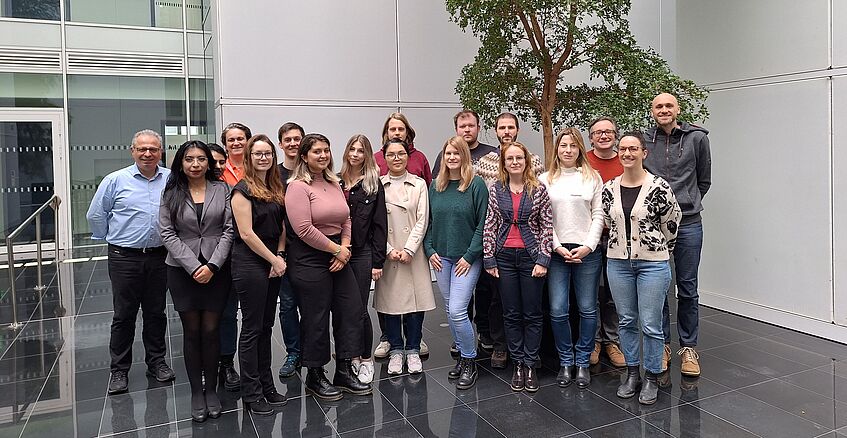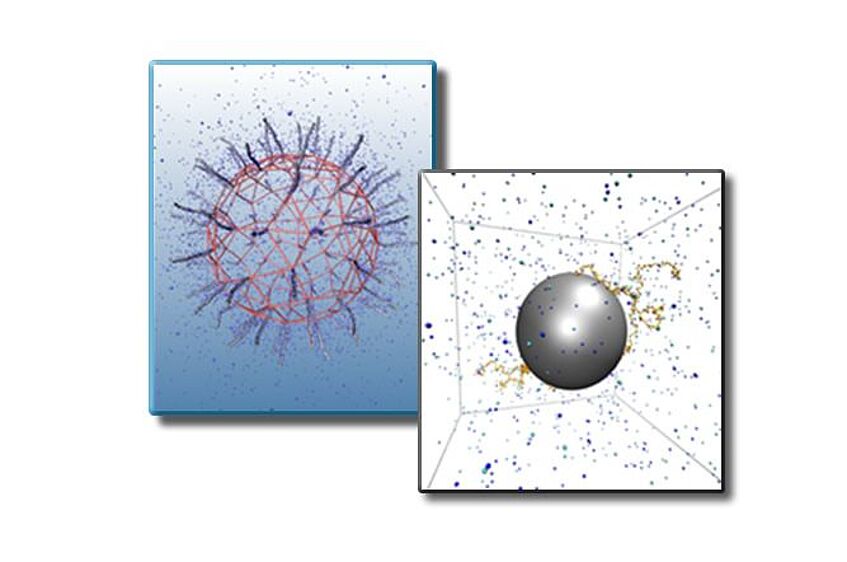
Soft Matter Theory and Simulation
Research and collaborations of the Likos group
Work in our group focuses on the research area of Theoretical and Computational Physics of Soft Condensed Matter. The term Soft Matter encompasses a large variety of systems of fundamental interest, possessing at the same time enormous technological and biological relevance, e.g.: polymers, colloids, DNA-molecules, proteins, membranes etc. Soft systems are characterized through three basic properties: first, they are solutions/suspensions of mesoscopic macromolecular aggregates on a microscopic solvent. Second, in stark contrast to their atomic counterparts, the effective forces between the dissolved particles can be tuned through changes in the architecture of the molecules, the temperature, as well as the salinity and the pH of the solvent. This property renders soft matter systems as prime candidates for the targeted and controlled design of material properties at the molecular scale, since the interparticle interactions dictate the macroscopic equilibrium and dynamical behavior of the system. Finally, another extremely important property of soft matter is its high sensitivity to external fields, which offer an additional possibility to externally steer the behavior of soft materials.

The central approach permeating our research philosophy is to perform accurate coarse-graining processes on the complex, multicomponent systems encountered in soft and biological matter, so as to drastically reduce the inherent complexity and bridge the scales from a (highly complex) microscopic one to a more manageable mesoscopic. Afterwards, the subsequent bridging from the mesoscopic to the macroscopic scale follows through rules, techniques and procedures known from the theory of simple fluids and crystals. This approach has proven extremely fruitful, e.g., in the domain of materials science and engineering, since it allows for the prediction of the forms of self-organization of matter, starting from the basis of the properties and architecture of the constituent macromolecules at the microscopic scale. What is even more important, the technique allows the study of not only equilibrium properties (fluid structure, crystallization) but also of dynamical ones (glass formation and rheology). The typical techniques that we apply along these lines draw from a diverse and mutually complementary pool of approaches, some of which have been co-developed and refined in the group: scaling theory of polymers, density functional theory (static and dynamical), integral equation theories, renormalization-group methods, phonon theories, genetic algorithms, as well as mode coupling theory of glass formation.

The program of the development of effective interactions has been successfully carried out thus far for a variety of systems, for which the length scales from microscopic to macroscopic have been bridged: star polymers, dendrimers, microgels and polyelectrolytes, ring and brush-polymers are some examples thereof. A host of novel phenomena, including exotic crystal phases, re-entrant melting and vitrification, cluster formation on novel types of cluster crystals, orientational order in columnar DNA assemblies and microgel organization under external fields have been discovered and, to a large part, experimentally confirmed. Current research focuses strongly on non-equilibrium phenomena and on systems of higher complexity, such as glasses, colloid-polymer complexes and polyelectrolytes, ring polymers and living polymers as well as active matter with explicit solvent. In what follows, a short list of the current research activities in the group is presented.
- Vitrification in soft mixtures. Collaboration with Emanuela Zaccarelli (Rome), Dimitris Vlassopoulos (Heraklion), Domenico Truzzolillo and Luca Cipelletti (Montpellier).
- Associating polymers. Collaboration with Athanassios Z. Panagiotopoulos (Princeton), Dimitris Vlassopoulos (Heraklion), Nikos Hadjichristidis (KAUST), and Emanuela Bianchi (Vienna).
- Ring polymer solutions and melts. Collaboration with Angel Moreno (San Sebastian) and Kurt Kremer (Mainz).
- Elasticity of soft colloids. Collaboration with Primoz Ziherl (Ljubljana), Emanuela Bianchi (Vienna), and Lorenzo Rovigatti (Rome).
- Inhomogeneously charged colloids. Collaboration with Emanuela Bianchi (Vienna).
- Statics and dynamics of cluster formation. Collaboration with Angel Moreno (San Sebastian), Mukta Tripathy (IIT Bombay), and Manuel Camargo (Cali, Colombia).
- Theory of interactions of microgels and polyelectrolyte brushes. Collaboration with Peter Schurtenberger (Lund), Jan Dhont (Jülich), Sofia Kantorovich (Vienna), Ronald Blaak (Clermont-Ferrant), and Thiago Colla (Minas Gerais, Brazil).
- Single-molecule polymer rheology. Collaboration with Cristian Micheletti (SISSA), Marisol Ripoll (Jülich), Arash Nikoubashman (Mainz), and Charles Schroeder (Illinois).
- Topologically constrained polymers. Collaboration with Mohammed Reza Ejtehadi (Teheran).
- Polymer rheology. Collaboration with Dimitris Vlassopoulos (Heraklion).
- DNA-based nanostructures. Collaboration with Manolis Stiakakis (Jülich), Uli Jonas (Siegen), and Dan Luo (Cornell).
- Active polymers. Collaboration with Davide Michieletto and Davide Marenduzzo (Edinburgh).
- Effective hydrodynamic techniques for soft colloids. Collaboration with Emanuela Zaccarelli (Rome) and Manuel Camargo (Cali, Colombia).
